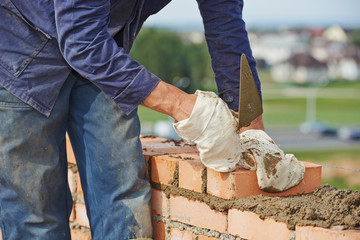Masonry involves building blocks, bricks, stone, and concrete structures. It requires construction professionals like Colorado Springs Masonry who have specialized skills in masonry materials. Masons learn their trade through an apprenticeship with experienced masons. Masonry work can be challenging, but the rewards are great.

The left-hand pillar of King Solomon’s Temple was adopted into speculative Masonry as an emblematical of Strength and Wisdom.
Bricks are a key component of Masonry, used for structural and non-structural (aesthetic) elements in construction. They are available in various sizes, colors, textures, and bonds. Bricks can be made from clay, cement, lime or calcium-silicate.
Bricks may be solid (with less than 25% perforation by volume), cellular, or hollow. In the latter case, they may be “frogged,” having indentations on one of the longer faces; this is done for ease of mortaring or to reduce weight. The frog should be filled with mortar when the brick is laid, otherwise it can adversely affect the structural and acoustic performance of the wall.
The color of a brick is influenced by the minerals in the soil it was made from and by the firing temperature and atmosphere in the kiln. For example, bricks made from clay with high levels of iron oxide have a reddish hue; while those from calcareous soil are yellow or white. The color of a brick can also be tinted to create different aesthetic effects.
The preparation of a brick involves three steps; preparing the clay, molding and drying. A brick is generally considered to be of first class quality when it has standard size and shape, a uniform color and has an excellent compressive strength of between 15 and 35 MPa.
There are several methods of making bricks; table-molded, dry-pressed and extruded. The former involves mixing the clay with water until it is soft enough to be molded into shape; the bricks are then dried by heating in a kiln. Dry-pressed bricks are similar to the soft-mud moulded type, but begin with a thicker clay mix and are subjected to greater pressure as they are pressed into steel molds.
A brick can be bonded together with mortar to form a solid unit, known as a course or a bond. The type of bond employed in a project will often depend on the architectural style being used; for example, American common bond has one course of headers every six stretcher courses. For efficiency in laying, a brick should be small enough and light enough to be picked up by the thumb and fingers of one hand without damaging it.
Stone
Stones are one of the most important materials in Masonry. They are used to build walls, foundations, columns and retaining structures. They can be natural or manufactured. The stones used in Masonry must be strong, tough and durable. They must also be free from cracks and holes. The stones should be thoroughly cleaned before they are used for Masonry.
There are several types of stones used in stone masonry, including granite, marble and limestone. These are derived from sedimentary rocks, which are created when mineral grains are deposited in a basin. Limestone and sandstone are the most common sedimentary rock types used in Masonry.
Fine-toothed ashlar masonry is the most expensive form of stone masonry, but it is also one of the most beautiful. This method uses a precise technique to create flawless couplings between adjacent stones, both horizontally and vertically. It is used for decorative elements in buildings such as lintels over doors and windows and in flat arches.
Rubble stone masonry is another popular type of stone masonry. This style is less costly than fine-toothed ashlar, but it requires more time and labor to achieve the same results. Rubble stones are rough and unprocessed, requiring masons to assemble them manually. They must be carefully chosen and positioned with meticulous accuracy to ensure that the pressure from the wall is spread over the maximum lateral area.
Polygonal rubble masonry is another type of stone masonry that may be used to construct a building. This style of Masonry is similar to that used by the Incans and other ancient civilizations. The stones are hammer-dressed on the face to an irregular polygonal shape. They are then bedded in position to show face joints running in all directions.
Post-tensioned stone is a special type of stone masonry that uses tensile forces to support the structure. It consists of stone blocks that are connected to each other by tendons threaded through a duct formed from aligned drilled holes. This system reduces the number of mortar joints, which can contribute to structural problems. It is most often used in the construction of bridges, skyscrapers and other large structures.
Concrete
Concrete Masonry consists of cement, stone and other aggregates mixed with water to form a material that hardens when it is dry. It is used to construct foundation walls, concrete slabs and other masonry structures. In addition, concrete is often reinforced with wire mesh or rebar to increase its strength and minimize cracking. It is also used to build stairs and other structural components of buildings.
In addition to providing the load bearing strength for a building, Masonry is an excellent insulator against heat and cold, and noise. Its ability to retain heat in the winter and block cold air in the summer makes it ideal for homes, office buildings and other commercial facilities.
It also provides better protection against break-ins and fires than many other building materials, which helps keep insurance rates lower. Masonry is a durable and long-lasting material that requires little maintenance to remain in good condition over the years.
The most common type of Masonry is brick and concrete, used to construct walls for homes and other buildings. Masonry is also used for walls in bridges and elevated slabs for parking structures and other commercial buildings. It is sometimes used in retaining walls and to make chimneys and fireplaces.
Masonry can be built in a variety of styles and sizes, from low-rise apartments to large skyscrapers. Walls constructed of Masonry are sturdy and provide an attractive appearance that can blend in with the surrounding architecture. Masonry is a popular material for walls in hospitals, schools and office buildings because it is fireproof and offers better security than other types of construction.
A good resource for understanding masonry construction is the US Army Field Manual, Builder Training Course Volume #1 (US Army FM 5-428). It provides basic explanations and instructions to help you become a competent mason.
Concrete Masonry is becoming increasingly popular, because it is less expensive than some other types of construction. It can also be manufactured in a range of colors and textures to suit any design requirements. It can be produced with recycled or “green” ingredients, which helps to reduce its environmental impact. It is easy to work with, and can be shaped into a wide variety of designs.
Mortar
Although a lot of attention is focused on the bricks and stones that make up Masonry, it’s the mortar that holds everything together. It’s important to know about how mortar works so that you can choose the right kind for your project.
Mortar is a combination of water, lime, cement, and fine aggregates like sand that holds bricks, concrete blocks, structural clay tile, stone, and other masonry materials together. It is usually mixed on-site, but ready-to-use mixes are available for smaller jobs.
Like concrete, mortar can be poured and screeded into place to form walls or other structures. It can also be used to fill in gaps between masonry units or to add texture to a surface. It’s important to use the right type of mortar for your project to ensure that it will be able to withstand the load and weather conditions.
There are several factors that affect the quality and durability of mortar, including its workability, strength, and adhesion. It’s important to test your mortar before using it in a construction project to ensure that it has the proper consistency and strength. It should also be water proof so that it can withstand the rainy season without being damaged.
The workability of mortar is affected by its moisture content, but other factors also contribute to its effectiveness. For example, the ratio of lime to cement and the gradation of the aggregates are important for determining how much water is needed for mixing. Also, the temperature of the ingredients can influence how well the mortar is mixed.
A good mortar will have a low slump, meaning that it won’t flow easily when being worked with. It should also have a high tensile strength and a low permeability, which will help it resist damage from freeze-thaw cycles. It should be able to withstand the pressure of gravity and moderate soil loads, as well as have a good bond with masonry units. In general, type N mortar is a good choice for most applications. It has a lower compressive strength than type S mortar, but it’s still strong enough for most applications.

